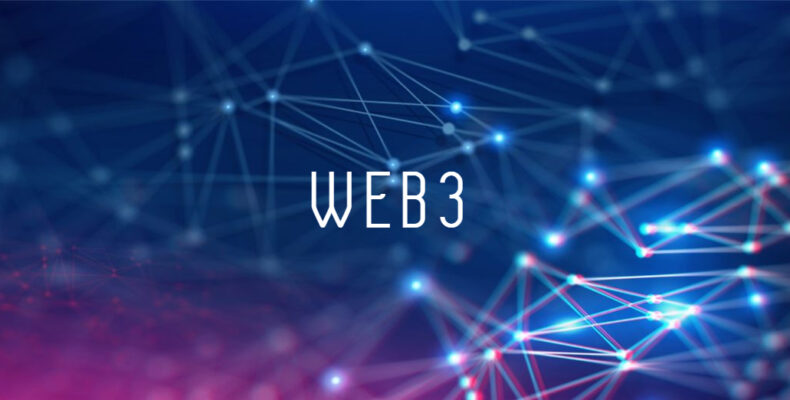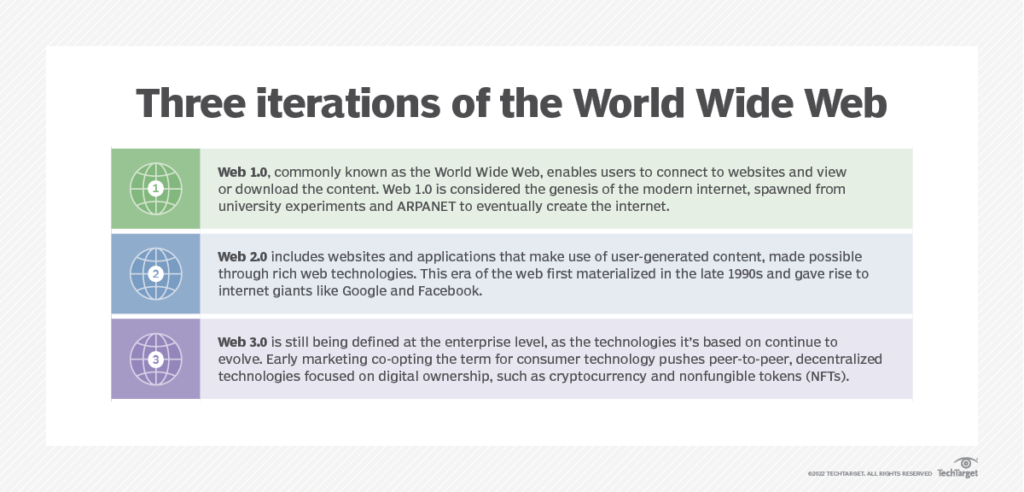To understand the latest phase of the internet, we must look back to the beginning. The internet was originally established as a tool to be used by the military to share intelligence. It was quickly absorbed by the scientific community, then formed into the marketing, social, communication network that we know today.
The first “wave” of internet use was never “labeled” until the phase “web 2.0” was identified, and coined as such. Hence, pre-Web 2.0 became known as Web 1.0.
What is Web 3?
Web3 (web 3.0) is the third generation of the evolution of web technologies. The web, also known as the World Wide Web, is the foundational layer for how the internet is used, providing website and application services.
The first generation of the web, sometimes referred to as Web 1.0, was invented and defined by Tim Berners-Lee in 1989. Web 1.0 was about basic access and connectivity across static websites. The first generation of the web lasted until approximately 2004 when Tim O’Reilly helped to coin the term Web 2.0.
Web 2.0 refers to websites and applications that utilize user-generated content for end users. Web 2.0 is used in many websites today, chiefly focusing on user interactivity and collaboration. Web 2.0 also focuses on providing more universal network connectivity and communication channels.
Web 3.0 is still evolving and being defined, and as such, there isn’t a canonical, universally accepted definition. What is clear, though, is that Web 3.0 will have a strong emphasis on decentralized applications and make extensive use of blockchain-based technologies. Web 3.0 will also make use of machine learning and artificial intelligence (AI) to help empower more intelligent and adaptive applications.
Another aspect that is part of the emerging definition of Web 3.0 is the notion of a semantic web. Among those that have advocated for the integration of semantic technology into the web is the creator of the web, Tim Berners-Lee.
It took over 10 years to transition from the original web, Web 1.0, to Web 2.0, and it is expected to take just as long, if not longer, to fully implement and reshape the web with Web 3.0.
If the trend of change is traced from Web 1.0, a static information provider where people read websites but rarely interacted with them, to Web 2.0, an interactive and social web enabling collaboration between users, then it can be assumed that Web 3.0 will change both how websites are made and how people interact with them.
How does Web 3.0 work?
With Web 1.0 and Web 2.0 technologies, Hypertext Markup Language (HTML) defines the layout and delivery of webpages. HTML will continue to be a foundational layer with Web 3.0, but how it connects to data sources and where those data sources reside could be somewhat different than earlier generations of the web.
Many websites and nearly all applications in the Web 2.0 era rely on some form of centralized database to deliver data and help to enable functionality. With Web 3.0, instead of a centralized database, applications and services make use of a decentralized blockchain. With blockchain, the basic idea is that there isn’t an arbitrary central authority, but rather a form of distributed consensus.
An emerging governance ideal within the blockchain and Web 3.0 community is the concept of a decentralized autonomous organization (DAO). Instead of having a central authority that governs the operations of a platform, with a DAO, Web 3.0 technologies and communities provide a form of self-governance in an attempted decentralized approach.
Web 3.0 also fundamentally works with cryptocurrency, more so than with fiat currency. Finance and the ability to pay for goods and services with a decentralized form of payment is enabled across Web 3.0 with the use of cryptocurrencies, which are all built and enabled on top of blockchain technology.
Both Web 1.0 and Web 2.0 were primarily built with the IPv4 addressing space. As a function of a massive growth of the web over the decades, there is a need in Web 3.0 for more internet addresses, which is what IPv6 provides.
Key Web 3.0 features
Web 3.0 may be constructed with AI, semantic web and ubiquitous properties in mind. The idea behind using AI comes from the goal of providing faster, more relevant data to end users. A website using AI should be able to filter through and provide the data it thinks a specific user will find appropriate. Social bookmarking as a search engine can provide better results than Google since the results are websites that have been voted on by users. However, these results can also be manipulated by humans. AI could be used to separate the legitimate results from the falsified, therefore producing results similar to social bookmarking and social media but without bad feedback.
An artificially intelligent web will also introduce virtual assistants, an element that is already emerging today as an aspect built into a device or through third-party apps.
The idea behind the semantic web is to categorize and store information in a way that helps teach a system what specific data means. In other words, a website should be able to understand words put in search queries the same way a human would, enabling it to generate and share better content. This system will also use AI; the semantic web will teach a computer what the data means, and then AI will take the information and use it.
There are several key Web 3.0 features that help to define what the third generation of the web will likely be all about, including the following:
-
Decentralized – As opposed to the first two generations of the web, where governance and applications were largely centralized, Web 3.0 will be decentralized. Applications and services will be enabled in a distributed approach, where there isn’t a central authority.
-
Blockchain-based – Blockchain is the enabler for the creation of decentralized applications and services. With blockchain, the data and connection across services are distributed in an approach that is different than centralized database infrastructure. Blockchain can also enable an immutable ledger of transactions and activity, helping to provide verifiable authenticity in a decentralized world.
-
Cryptocurrency-based – Cryptocurrency usage is a key feature of Web 3.0 services and largely replaces the use of fiat currency.
-
Autonomous and Artificially Intelligent – More automation overall is a critical feature of Web 3.0, and that automation will largely be powered by AI.
Web 3.0 vs. Web 2.0
Web 3.0 is the successor to two previous generations of the web.
The first generation of the web, sometimes referred to as Web 1.0, was invented and defined by Tim Berners-Lee in 1989. Web 1.0 was about basic access and connectivity across static websites. The first generation of the web lasted until approximately 2004 when Tim O’Reilly helped to coin the term Web 2.0.
Web 2.0 refers to websites and applications that utilize user-generated content for end users. Web 2.0 is used in many websites today, chiefly focusing on user interactivity and collaboration. Web 2.0 also focuses on providing more universal network connectivity and communication channels.
The difference between Web 2.0 and 3.0 is that Web 3.0 is more focused on the use of technologies like machine learning and AI to provide relevant content for each user instead of just the content other end users have provided. Web 2.0 essentially enables users to contribute and sometimes collaborate on site content, while Web 3.0 will most likely turn these jobs over to the semantic web and AI technologies. Web 3.0 also focuses strongly on decentralized services and authority, which is a marked contrast to the centralization of Web 2.0.
| Web 1.0 | Web 2.0 | Web 3.0 |
|
Created in 1989 by Tim Berners-Lee |
Term coined by Tim O’Reilly in 2004 |
Modern usage with blockchain defined by Gavin Wood, co-founder of Ethereum, in 2014 |
|
Static website content |
Dynamic content and user input |
Semantic content that can benefit from AI |
|
Information delivery |
Social networks |
Metaverse worlds |
|
Centralized infrastructure |
Cloud utility infrastructure that is still largely centralized |
Decentralized, edge computing and peer-to-peer |
|
Relational database-driven content and application delivery |
Blockchain-based distributed services |
|
Web 3.0 applications
With blockchain at the foundation, Web 3.0 enables a growing number of different types of new applications and services to exist, including the following:
-
NFT. Nonfungible tokens (NFTs) are tokens that are stored in a blockchain with a cryptographic hash, making the token unit unique.
-
DeFi. Decentralized finance (DeFi) is an emerging use case for Web 3.0 where decentralized blockchain is used as the basis for enabling financial services, outside of the confines of a traditional centralized banking infrastructure.
-
Cryptocurrency. Cryptocurrencies like Bitcoin are Web 3.0 applications that create a new world of currency that aims to be separate from the historical world of fiat currency.
-
dApp. Decentralized applications (dApps) are applications that are built on top of blockchain and make use of smart contracts to enable service delivery in a programmatic approach that is logged in an immutable ledger.
-
Cross-chain bridges. There are multiple blockchains in the Web 3.0 world, and enabling a degree of interoperability across them is the domain of cross-chain bridges.
-
DAOs. DAOs are set to potentially become the organizing entities for Web 3.0 services, providing some structure and governance in a decentralized approach.
Source: https://www.techtarget.com/whatis/definition/Web-30
More articles about Web3
Web3 is in chaos and metaverses are in their own walled gardens, says Randi Zuckerberg.




